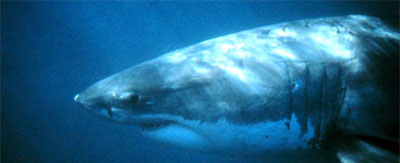|

The Sixth Sense: Great Whites have a sixth sense given by the Ampullae of Lorenzini,
which enables them to detect the electromagnetic field emitted by
the movement of living animals. A Great White's sense of sight is
useful, but the shark does not depend on it. A shark primarily uses
its extra senses (i.e, Electrosense and Mechanosense) to locate
prey from far off. Then, the shark uses smell and hearing to further
verify that its target is food. At close range, the shark utilizes
sight for the attack.
 Ambush Predator: The shark will often in ambush deliver a massive
disabling bite and then back off to allow the prey to expire. This
tactic allows the animal to avoid combat with dangerous prey, such
as sea lions. Ambush Predator: The shark will often in ambush deliver a massive
disabling bite and then back off to allow the prey to expire. This
tactic allows the animal to avoid combat with dangerous prey, such
as sea lions.
It also has allowed occasional rescue of humans bitten
by the animal, though it appears to attack humans mostly in error.
Bad Reputation: White sharks' reputation as ferocious predators is well-earned,
yet they are not (as was once believed) indiscriminate "eating
machines". They typically hunt using an "ambush"
technique, taking their prey by surprise from the bottom.
This is
the only shark known to lift its head above the sea surface to gaze
at other objects such as prey; this is known as "spy-hopping".
It is theorized that the shark may also be able to smell better
this way, since smells travel through air faster than through water.
On the Menu: Great White sharks primarily eat fish, smaller sharks, turtles,
dolphins, and pinnipeds such as seals and sea lions. They are apex
predators; the only animals known to attack them are other Great
Whites, sperm whales and orcas.

Rows and Rows of Teeth: Great Whites, like many other sharks, have rows of teeth behind
the main ones, allowing any that break off to be rapidly replaced.
Their teeth are unattached to the jaw and are retractable, like
a cat's claws, moving into place when the jaw is opened. Their teeth
also rotate on their own axis (outward when the jaw is opened, inward
when closed). The teeth are linked to pressure and tensor-sensing
nerve cells. This arrangement seems to give their teeth high tactile
sensitivity.
Sizes and Scales: While the average length of a Great White is 4 to 5 meters (females
generally being larger than males), the question of the maximum
size of Great White sharks has been subject to much debate, conjecture,
and misinformation. Today, most experts contend that the Great White's
"normal" maximum size is about 6 m (20 ft), with a maximum
weight of about 1900 kg (4200 lb). Any claims much beyond these
limits are generally regarded as doubtful, and are closely scrutinized.

Shark Life-cycle: A White Shark can reproduce when a male's length is around 3.8 m
and a female's length is around 4.5 to 5 meters. Their lifespan
has not been definitively established, though many sources estimate
30–40 years. It would not be unreasonable to expect such a
large marine animal to live longer however.

Mysterious Mating: There is still a great deal that is unknown about Great White behavior,
such as mating habits. Birth has never been observed, but several
pregnant females have been examined. Great Whites are ovoviviparous,
the eggs developing in the female's uterus, hatching there and continuing
to develop until they are born, at which point they are perfectly
capable predators. The embryos can feed off unfecundated eggs. The
delivery takes place in the period transitioning spring and summer.
Almost nothing is known about how and where the Great White mates.
All text is available under the terms
of the GNU Free Documentation License
|